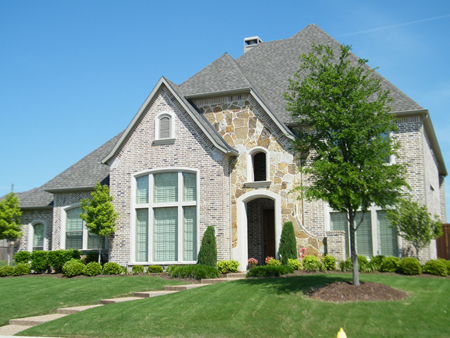Designing your landscape is both challenging and rewarding. You want it to be a relaxing place for you and your family. But most of all, you want your landscape to attract the eye of all your friends and neighbors. There are different ways to design your ideal landscape. Here are some tips for landscaping in Denver.
#1 Decorate Your Landscape with Beautiful Hardscaping
Hardscaping comes in many shapes and sizes. Examples include structures such as:

- Walls,
- Patios,
- Walkways,
- Decks,
- Gazebos,
- Fire pits,
- Benches,
- Statutes,
- Outdoor kitchens, and
- Fountains.
With hardscaping, you can create the theme of your landscaping. Hardscaping can add character to your landscaping, whether modern, classic, informal, or desert.
Benches can provide comforting rest spots around your yard. Outdoor kitchens provide a place for gatherings with friends and family. Fountains and gazebos can add elegance to your landscaping, while patios and walkways can add convenience and comfort.
#2 Conserve the Utilities of Your Beautiful Landscaping
Landscaping in Denver accounts for about 50% of a resident’s water use. Design your landscape with this in mind.
One trick to conserve water is to plant Colorado native trees and flowers. These plants use less water than non-native plants. You can also have a timed sprinkler system. This way, you can set the system to water your plants at a specific time. Be wary of the times the city of Denver allows for lawn watering.
You’ll use less water than you’d probably use manually with a water hose. Also, you don’t have to worry about when to water your plants.
Your landscaping will use electricity as well. Lighting gives comfort and elegance to your landscaping. Lighting is especially important when it gets dark. But this will use more electricity.
Investing in an automatic lighting system can be beneficial. One that turns on automatically based on the sun would be ideal. You won’t have to worry about turning on the lights, and you will also conserve energy. And having automatic lighting will be a classy feature for your gorgeous landscaping.
#3 Design Your Landscape to Reduce the Risk of Wildfire
In a 2023 study by CoreLogic, Colorado was the second-highest state for the most homes at risk for a wildfire. The Denver metropolitan area had almost 70,000 homes at risk for a wildfire.
This fire threat may seem disconcerting. But did you know you could design your landscape to help prevent the spread of a wildfire to your home and protect your neighbors?
Build Hardscapes Around Your Landscape
Apart from aesthetics, hardscapes can also reduce the fire risk around your home. Walkways can separate lawn areas from each other, minimizing the spread of a fire from one section to another.
Walls separating flower beds can also prevent fires from jumping to the next section of greenery. Patios can serve as a barrier around your home.
Use Inorganic Mulch
Another option is to look into inorganic mulch. While organic mulch, like pine needles, helps your greenery absorb nutrients and grow, it can also fuel a fire. Inorganic mulch, such as rocks, may help prevent the spread of a fire.
Organize Your Greenery to Prevent Fires
When you plant your greenery, arrange it to prevent the spread of a fire. For example, spacing plants and trees out can provide a buffer, helping to prevent fires from spreading from one plant to the next. You can also plant flowers and shrubs in small groups, preferably with some hardscape around them.
#4 Design Your Landscape with Privacy in Mind
Another way to have a beautiful yard is with privacy. As human beings, we value privacy. Privacy represents freedom and safety. And we need that in our homes and yards. You can design your landscape to capture this privacy in many different ways.
Building a boundary around your home is one classic way to achieve privacy for your landscape. You can plant hedges along the boundary of your home. These hedges provide the utmost privacy, especially if you choose a year-long plant. Another example is to add some kind of fence around your property.
#5 Plant Greenery with Low Maintenance
Consider planting greenery native to Colorado. Plants native to Colorado are in their native soil. Therefore, they are much easier to maintain than non-native plants. And as a bonus, they use less water than non-native plants. Typical native Colorado greenery includes:
- Rocky Mountain juniper,
- Mountain mahogany,
- Bush sunflower,
- Indian rice grass, and
- Spreading daisies.
Planting this greenery is also good for the environment. Construction and human expansion have killed a lot of native Colorado vegetation. Thus, by planting native Colorado plants, you are rebuilding the ecosystem.
Contact Westside Grounds for Your Denver Landscaping Ideas
At Westside Grounds, our professionals have been helping Denver and Lakewood residents build stunning backyard and beautiful front yard landscaping since 1999. We offer a variety of services, including lawn care, landscape construction, and yard maintenance, such as the following:
- Lawn aeration,
- Weed control,
- Overseeding,
- Fungus control,
- Fertilization,
- Pest control,
- Hedge trimming, and
- Gutter cleaning.
Our specialists can help you build dazzling landscaping for your home. Call Westside Grounds today and speak to one of our landscaping experts.




